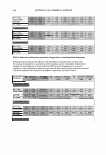ADHESION FAILURE IN HAIR 371 generally involves bonding between hydrophobic layers (beta-delta failure). Chemical damage by permanent waves, bleaches, and sunlight can influence the initial sites of failure and increase the number of possible routes for crack propagation, thus leading to more complex fracture patterns. REFERENCES (1) C. Robbins, Chemical and Physical Behavior of Human Hair, 4th Ed. (Springer-Verlag, New York, Berlin, Heidelberg, 2002), pp. 256-288. (2) J. A. Swift, Human hair cuticle: Biologically conspired to the owner's advantage,]. Cosrnet. Sci., 50, 23-47 (1999). (3) L. N. Jones and D. E. Rivett, The role of 18-methyleicosanoic acid in the structure and formation of mammalian hair fibers, Micron, 28, 469-485 (1997). (4) A. P. Negri, H.J. Cornell, and D. E. Rivett, A model for the surface of keratin fibers, Textile Res.]., 63, 109-115 (1993). (5) W. G. Bryson et al., Characterization of proteins obtained from papain/dithiothreitol digestion of Merino and Romney wools, Proceedings of the 9th International Wool Textile Research Conference, Biel/a, Italy, 463-472 (1995). (6) R. B. D. Fraser, T. P. MacRae, and G. E. Rogers, Keratins, Their Composition, Structure and Biosynthesis, Ch. 4. (Charles C. Thomas, Springfield, IL, 1972). (7) A. Negri et al., A transmission electron microscope study of covalently bound fatty acids in the cell membranes of wool fibers, Textile Res.]., 66, 491-495 (1996). (8) A. K. Allen, J. Ellis, and D. E. Rivett, The presence of glycoproteins in the cell membrane complex of a variety of keratin fibers, Biochirn. Biophys. Acta, 1074, 331-333 (1991). (9) M. Blaber, Membranes & structure of membrane proteins, General Biochemistry Lecture 14, www. wine/. sb.fsu. edu! bch40 5 3 !notes_rn. htrn. (10) F. Briki, L. Kreplak, C. Merigoux, and]. Doucet, 12th International Hair-Science Symposium, Heidelberg, Germany, September 5-7 (2001). (11) C. Robbins, Chemical and Physical Behavior of Human Hair, 4th Ed. (Springer-Verlag, New York, Berlin, Heidelberg, 2002), pp. 388-391. (12) Y. K. Karnath and H. D. Weigmann, Fractography of human hair,]. Appl. Polymer Sci., 27, 3809- 3833 (1982). (13) M. Gamez-Garcia, Cuticle decementation and cuticle buckling produced by Poisson contraction on the cuticular envelope of human hair,]. Soc. Cosrnet. Chern., 49, 213-222 (1998). (14) M. Feughelman and B. K. Willis, Mechanical extension of human hair and the movement of the cuticle,]. Cosrnet. Sci., 52, 185-193 (2001). (15) C. Robbins, Chemical and Physical Behavior of Human Hair, 4th Ed. (Springer-Verlag, New York, Berlin, Heidelberg, 2002), pp. 411, 442. (16) Y. K. Karnath, S. B. Hornby and H. D. Weigmann, Mechanical and fractographic behavior of Negroid hair,]. Soc. Cosmet. Chem., 35, 21-43 (1984). (17) M. Gamez-Garcia, The cracking of human hair cuticles by cyclical thermal stresses,]. Soc. Cosmet. Chem., 49, 141-154 (1998). (18) S. B. Ruetsch and H. D. Weigmann, Mechanism of tensile stress release in the keratin fiber cuticle, ]. Soc. Cosmet. Chern., 47, 13-26 (1996). (19) S. B. Ruetsch, Y. K. Karnath, and H.-D. Weigmann, The role of cationic conditioning compounds in reinforcement of the cuticula.,]. Cosmet. Sci., 54, 63-84 (2003). (20) S. Sandhu and C. Robbins, A simple and sensitive technique based on protein loss measurements to assess surface damage to human hair,]. Soc. Cosmet. Chem., 44, 163-175 (1993). (21) S. B. Ruetsch, Y. K. Karnath, and H.-D. Weigmann, Photodegradation of human hair: An SEM study, ]. Cosmet. Sci., 51, 103-125 (2000). (22) D. J. Evans and M. Lanczki, Cleavage of integral surface lipids of wool by aminolysis, Textile Res.]., 67, 435-444 (1997).
]. Cosmet. Sci., 55, 373-385 Guly/August 2004) Comparison of age-related changes in wrinkling and sagging of the skin in Caucasian females and in Japanese females KAZUE TSUKAHARA, TSUTOMU FUJIMURA, YASUKO YOSHIDA, TAKASHI KITAHARA, MITSUYUKI HOTTA, SHIGERU MORIWAKI, PAMELA S. WITT, F. ANTHONY SIMION, and YOSHINORI TAKEMA, Biological Science Laboratories, Kao Corporation, Tochigi, Japan (K. T., T.F., Y. Y., T.K., M.H., S.M., Y. T.), and The Andrew Jergens Company, Cincinnati, Ohio (P.S. W., F.A.S.). Accepted for publication May 21, 2004. Synopsis We compared age-related changes in wrinkles in eight areas of facial skin (forehead, glabella, upper eyelid, corner of the eye, lower eyelid, nasolabial groove, cheek, and corner of the mouth) and sagging in the subzygomatic area of Caucasian females and of Japanese females. The subjects studied included 85 healthy Caucasian females (ages 20-69 years) living in Cincinnati in the U.S. and 70 Japanese females (ages 20-69 years) living in Tokyo. Photos of the face in frontal and in oblique 45 ° views were analyzed. Wrinkles in the face and sagging in the subzygomatic area were graded on Japanese photoscales, respectively, by the same experienced observer. The wrinkle score increased with age in all eight areas of the face examined in Caucasian females as well as in Japanese females. In the group aged 20-29 years, the wrinkle score in each area was significantly higher in Caucasian females than in Japanese females. The wrinkle scores in the forehead, glabella, upper eyelid, and corner of the eye were similar at advanced ages between the two groups, while the wrinkle scores in lower areas of the face (lower eyelid, nasolabial groove, cheek, and corner of the mouth) were markedly higher in Caucasian females than in Japanese females in each age group, and reached an upper limit at advanced ages in Caucasian females. The sagging score also increased with age in Caucasian females as well as in Japanese females. The sagging score was significantly higher in Caucasian females than in Japanese females in the groups aged 40 years or more. These results suggest more marked wrinkle formation in all areas of the face in younger age groups of Caucasian females living in North America than in Japanese females living in Tokyo. In particular, Caucasian females showed marked age-related wrinkle formation in the lower areas of the face, probably due to sagging in the subzygomatic area, which suggests a higher susceptibility to sagging in the subzygomatic area of Caucasian females. Address all correspondence to Kazue Tsukahara. 373
Purchased for the exclusive use of nofirst nolast (unknown) From: SCC Media Library & Resource Center (library.scconline.org)






































































































